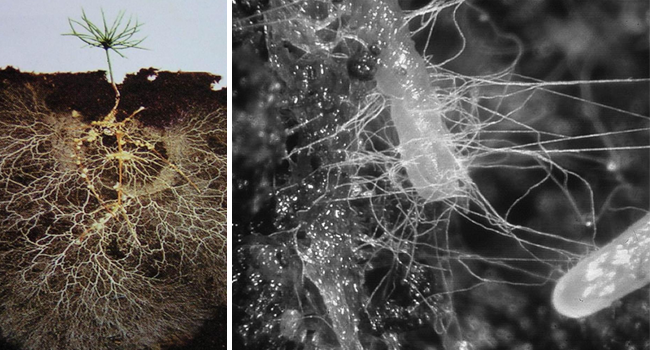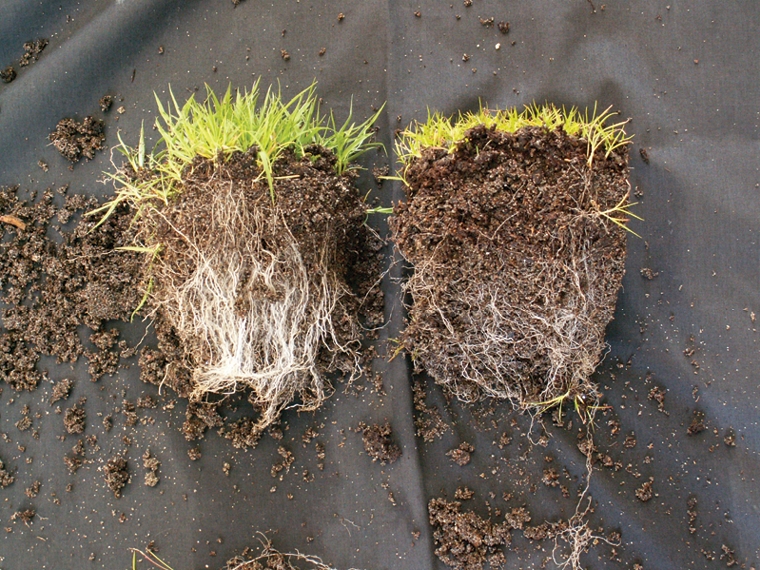TREES TALK: STORIES OF UNDERGROUND FOREST NETWORKS
We often think of trees as silent, solitary giants—but in reality, they’re part of an incredible underground network that allows them to communicate, share, and survive together. This hidden system is powered by something most of us never see: fungi.
ANCIENT ALLIANCES
Mycorrhizae (singular: mycorrhiza) are microscopic fungal threads that form a long-term, mutually beneficial partnership with plant roots in the rhizosphere—the thin layer of soil surrounding a plant’s root system.
Beneath the forest floor, these so-called “fungus roots” (from the Greek mykes meaning fungus, and rhiza meaning root) weave individual trees into a much larger underground network.
These fungi don’t simply grow near roots—they fuse directly with them, forming a symbiotic relationship.
The fungi extend far into the soil, increasing the plant’s access to water and hard-to-reach nutrients like phosphorus and nitrogen. In exchange, the plant supplies the fungi with sugars produced through photosynthesis, providing energy for the fungi to thrive.
What’s especially remarkable is that this relationship doesn’t stop at one plant. These networks can link multiple trees together, even those of different species, sizes, and ages. In effect, each tree becomes a node in a vast underground network—a biological system so intricate and efficient, it’s often referred to as the Wood Wide Web.

WHAT ARE TREES SAYING?
Here’s where things get fascinating. Scientists have discovered that through this network, trees can:
🌿 Share nutrients — Stronger trees send carbon or nutrients to weaker or younger ones, especially in times of stress.
🌿 Send warnings — When a tree is attacked by pests, it can signal its neighbours to boost their chemical defences. Think of it as a forest-wide “heads up.”
🌿 Prioritize family — Trees seem to recognize their own offspring and preferentially support them, sending more resources their way.
This changes how we view forests—not as a competition for sunlight and space, but as a cooperative, social network where survival is shared.
FUNGI OR FUN GUYS?
Though we often associate fungi with rot and decay, many types are here for a good time - playing an essential role in forest health. Without mycorrhizal fungi, trees would grow slower, be more vulnerable to disease, and struggle during droughts.
In fact, over 90% of land plants depend on fungi to survive. That includes trees, wildflowers, even many of the crops we eat.
And here’s something that surprises most people: those mushrooms you see dotting the forest floor? They’re not the whole fungus. They’re just the fruiting bodies—the reproductive organs that release spores (kind of like seeds).
The real fungus is below ground, made up of an intricate network of microscopic threads called hyphae. These threads grow outward in every direction, exploring, absorbing, and connecting with roots. When enough of them cluster together, they form what’s called a mycelium—a massive underground web that can stretch for kilometers.
It’s a bit like spotting an apple on a tree. The mushroom is just the visible part. The real organism—the roots, trunk, and branches—is hidden out of sight, quietly doing the hard work.
PROTECTING NETWORKS
The health of a forest isn't just measured in what we see—soaring trees, vibrant leaves, or scenic lookouts. It’s also about what’s happening underground, in the hidden world of roots and fungal threads.
When we damage the soil or disrupt these delicate systems, we don’t just hurt one tree—we compromise the entire network that keeps the forest healthy and connected.
Here’s how you can help protect these underground allies and the ecosystems that depend on them:
✅ Stay on trails – Walking off-path compacts soil and damages delicate fungal networks.
✅
Avoid disturbing soil unnecessarily – Especially in wild areas, avoid digging or moving natural elements.
✅
Support native species – Native trees and fungi evolved together. Planting or preserving them helps sustain natural partnerships.
✅
Donate or volunteer – Land trusts like the Algoma Highlands Conservancy protect entire ecosystems, from treetop to taproot.
THE FOREST IS LISTENING
At the Algoma Highlands Conservancy, our focus goes beyond protecting scenic views and well-known landmarks. We are committed to conserving the entire forest system—including the complex and often overlooked ecosystems beneath the surface.
The health of a forest relies not only on what we see above ground, but on the intricate networks below it. These underground systems—formed by roots, fungi, and soil organisms—are essential to the survival, resilience, and long-term stability of forest ecosystems.
By understanding and protecting these systems, we can make more informed decisions about land use, recreation, restoration, and stewardship.
It’s not just a collection of trees. It’s a living system—interconnected and interdependent. And as we continue to learn more about how forests function, it becomes increasingly clear just how much is at stake—not just for biodiversity, but for climate stability, clean water, and future generations.
If you value this kind of work, we
invite you to support it.
Whether through membership, volunteering, or donation, your contribution helps protect the full picture—from canopy to forest floor.





